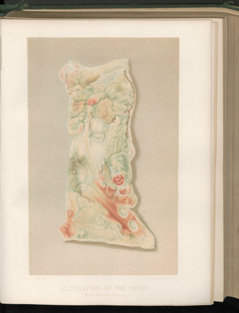Title: Glascow, Taylor W.
Source text: The Medical and Surgical History of the War of the Rebellion. (1861-65.), Part 2, Volume 1 (Washington, DC: Government Printing Office, 1879), 449.
Civil War Washington ID: med.d1e41915
TEI/XML: med.d1e41915.xml
Somewhat similar is the character of the ulcers shown in the chromo-plate facing page 454. The following is a history of the case:
CASE 897.—Private Taylor W. Glascow, company H, 110th Pennsylvania volunteers; age 34; admitted to Emory hospital, Washington, D. C., October 17, 1863. Chronic diarrhœa. This man enlisted September 25, 1862, and is reported on the muster-rolls of his company as present until March, 1863. Some time during April he was taken sick and sent to division hospital. June 14, 1863, he was admitted to the 1st division Alexandria hospital. Diagnosis, typhoid fever. He was, however, now in a convalescent condition, and was returned to duty with his regiment, August 11th. Shortly after he was attacked with dysentery, for which he was finally admitted to Emory hospital, as above stated. His disease now presented the aspect of a chronic flux. He was treated at first with pills of camphor and opium, but as the discharges from the bowels continued unabated, he was put to bed on the 21st, and tannic acid and opium substituted. Light diet. The diarrhœa was checked for a few days, but again grew worse about November 1st, when a chalk mixture was prescribed and a diet of boiled milk and toast. November 5th, he complained of pain in the abdomen. The diarrhœa was about the same. Substituted Parrish's camphor mixture and laudanum. November 11th, the patient complained of being unable to sleep. The diarrhœa remains about the same. Ordered mercury with chalk, and Dover's powder at night. November 16th, is worse. Stools more frequent. The patient appears much debilitated. Ordered pills of acetate of lead, opium and ipecacuanha; stimulants. Under this treatment he was again temporarily better, but again became worse about the 25th, when calomel and opium were substituted. December 3d, is much weaker; the diarrhœa unchecked. Stopped the pills; continued the stimulants. December 4th, at the request of the patient, procured him some blackberry brandy, which he seemed to relish; but in a few days discontinued its use, as it seemed to nauseate him. December 8th, is considerably emaciated, greatly prostrated and growing rapidly weaker. The stools are very frequent and tinged with blood. Ordered beef tea, brandy and a laudanum injection at night. Died, December 13th. Autopsy: The colon was considerably thickened and extensively ulcerated. [The condition of the other organs is not recorded.]—Acting Assist. Surgeon W. H. Combs. [No. 115, Medical Section, Army Medical Museum, is from this case.]
A portion of the descending colon from this case was brought to the Army Medical Museum immediately after the autopsy, and a water-color drawing made by Mr. Hermann Faber, of which the chromo-plate is a reproduction. The piece presents a number of ulcers, some of them of considerable size, which for the most part do not penetrate to the muscular coat, but invade the submucous connective tissue more or less deeply. The general surface of the mucous membrane between the ulcers is cream colored, with bluish and greenish streaks and patches. There are also a number of reddish patches in which the congested condition of the small veins is recognizable with the unaided eye. The bases of the ulcers are for the most part quite smooth, and similar in tint to the mucous membrane itself, but two of them are stippled with minute granulations; their edges are bevelled or rounded, not overhanging. This case, like the last, is to be interpreted as one of acute diphtheritic dysentery, which, in this instance, occurred not long after convalescence from typhoid fever. The precise duration of the disease is not shown by the record. It clearly commenced some time after the 11th of August, when the patient had sufficiently recovered from typhoid fever to be returned to his regiment for duty; but it cannot have commenced very long afterwards, for when admitted to Emory hospital the disease had already so far advanced as to present the characters of a chronic flux. The duration of his last illness must therefore have probably been somewhere between three and four months, a sufficient time to permit the complete separation of all the diphtheritic sloughs, but the resulting ulcers were too numerous and extensive to permit recovery. The physician who made the autopsy was unacquainted with the fact that the patient had previously suffered from typhoid fever, and does not appear to have examined the small intestine for traces of that disease.
